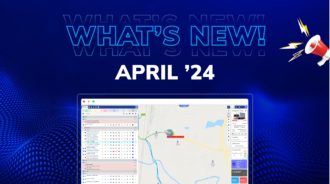In today’s fast-paced logistics industry, the need for robust and innovative fleet management cannot be overstated. The shift from traditional methods to technologically advanced solutions is paramount for businesses looking to thrive. This comprehensive blog explores how Trakzee, a cutting-edge fleet management software, is redefining the standards of modern logistics. We’ll discuss its multifunctional capabilities, alignment with current trends, and the myriad ways it enhances fleet operations, all while maintaining a focus on simplicity and user engagement.
Understanding Modern Fleet Management Needs:
Understanding modern fleet management needs involves a comprehensive assessment of the requirements and challenges faced by businesses and organizations that rely on fleets of vehicles to conduct their operations. Fleet management has evolved significantly in recent years due to advancements in technology, changing customer expectations, environmental concerns, and the need for efficient and cost-effective operations. Here are some key aspects to consider when discussing modern fleet management needs:
Technology Integration:
Modern fleet management heavily relies on technology to monitor, track, and optimize vehicle performance and operations. Telematics systems, GPS tracking, vehicle diagnostics, and connected devices are used to collect real-time data on vehicle location, fuel consumption, driver behavior, and maintenance requirements.
Data Analytics:
Fleet managers need access to sophisticated data analytics tools to make sense of the vast amount of data generated by their vehicles. Analyzing this data can help optimize routes, reduce fuel consumption, improve driver safety, and enhance overall operational efficiency.
Cost Control:
Controlling operational costs is a top priority in fleet management. This includes managing fuel expenses, maintenance costs, insurance, and labor expenses. Understanding modern fleet management needs involves finding ways to reduce costs while maintaining service levels and compliance with regulations.
Environmental Sustainability:
Many organizations are now focused on reducing their carbon footprint and promoting sustainability. Fleet managers need to consider options like hybrid and electric vehicles, route optimization to reduce emissions, and adopting eco-friendly driving practices.
Regulatory Compliance:
Compliance with various regulations, such as Hours of Service (HOS) rules for drivers, emissions standards, and safety regulations, is crucial in modern fleet management. Staying informed about and adhering to these regulations is essential to avoid fines and penalties.
Driver Safety and Training:
Ensuring the safety of drivers and the public is a fundamental concern. Modern fleet management requires investment in driver training programs, monitoring driver behavior, and implementing safety measures such as dash cams and driver assistance systems.
Customer Expectations:
Meeting customer expectations for on-time deliveries and transparency is critical. Modern fleet management involves using technology to provide real-time updates to customers and optimize routes for efficient and timely service.
Asset Management:
Beyond vehicles, modern fleet management may also involve managing other assets like trailers, containers, and equipment. Tracking the location and status of these assets is crucial for operational efficiency.
Scalability and Flexibility:
Businesses need fleet management solutions that can scale with their growth and adapt to changing needs. Scalability and flexibility in terms of technology and fleet size are essential considerations.
Predictive Maintenance:
Proactively identifying and addressing maintenance needs through predictive maintenance techniques can prevent breakdowns, reduce downtime, and extend the lifespan of vehicles.
Cost-Benefit Analysis:
Fleet managers must regularly conduct cost-benefit analyses to assess the value of investments in technology, vehicle upgrades, or process changes. This helps in making informed decisions that contribute to overall profitability.
The Role of Trakzee in Revolutionizing Fleet Management:
- Comprehensive Tracking: Trakzee goes beyond basic GPS tracking, offering insights into vehicle status, driving behavior, and more. This helps in making informed decisions that enhance operational efficiency.
- Maintenance and Alerts: The software’s maintenance alerts help prevent costly breakdowns, ensuring vehicles are serviced in time, which prolongs their lifespan and ensures consistent performance.
- Safety and Compliance: By monitoring driving patterns, Trakzee helps promote safe driving behavior and ensures compliance with road safety regulations, which is crucial for reducing accidents and liabilities.
Trends Shaping the Future of Fleet Management:
- Integration of IoT: The Internet of Things (IoT) allows for a network of connected devices, providing real-time data that can be used to optimize routes, monitor vehicle health, and improve overall fleet efficiency.
- The Rise of AI and Data Analytics: Artificial intelligence and analytics play a crucial role in predicting maintenance needs, optimizing routes, and understanding trends that can lead to more informed decision-making.
- Sustainability Initiatives: There’s a growing trend towards eco-friendly fleets. Trakzee supports this by optimizing routes for fuel efficiency and helping to reduce the overall carbon footprint.
The Benefits of Comprehensive Fleet Management Solution:
- Enhanced Efficiency: With real-time tracking and route optimization, fleets can complete more trips in less time, thereby increasing the bottom line.
- Cost Savings: Proactive maintenance and optimized routes lead to significant savings on fuel and repairs.
- Improved Safety: Monitoring driver behavior helps in promoting safe driving habits and reducing the likelihood of accidents.
- Competitive Advantage: By adopting advanced fleet management solutions, businesses can offer faster, more reliable services, thereby attracting and retaining customers.
How Trakzee Empowers Fleet Managers:
- Intuitive Interface: Trakzee is designed to be user-friendly. It ensures that managers can easily navigate and extract the information they need without unnecessary complexity.
- Customization: Managers can tailor the dashboard to focus on the metrics that matter most to their operations, whether it’s fuel usage, driver performance, or maintenance schedules.
- Alerts and Reports: Automated alerts and detailed reports ensure that managers are always aware of their fleet’s performance and can quickly address any issues that arise.
Implementing Trakzee in Your Operations:
-
Needs Assessment:
- Begin by conducting a thorough assessment of your operational requirements. Identify key challenges, goals, and specific features needed for effective fleet management.
-
Customization and Configuration:
- Tailor Trakzee to your unique needs through customization options. Configure settings, alerts, and reporting parameters to align with your business processes.
-
Data Migration:
- Streamline the transition by efficiently migrating data from your existing systems to Trakzee. Ensure the accurate transfer of essential information without disruption.
-
User Training:
- Empower your team with comprehensive training sessions. From basic functionalities to advanced features, ensure that every user understands how to maximize the benefits of fleet management soltuion.
-
Seamless Integration:
- Integrate Trakzee seamlessly into your existing infrastructure. Leverage its compatibility with various devices and systems to maintain continuity without the need for significant changes.
-
Testing and Validation:
- Conduct thorough testing to validate the system’s functionality within your operational environment. Identify and address any potential issues before full deployment.
-
Pilot Deployment:
- Opt for a pilot deployment in a controlled environment to observe Trakzee in action. Gather feedback from users and make any necessary adjustments to optimize performance.
-
Full-Scale Deployment:
- Once satisfied with the pilot phase, proceed with the full-scale deployment of Trakzee across your entire fleet. Implement any additional configurations based on real-world usage.
-
Monitoring and Support:
- Establish ongoing monitoring procedures to track system performance. Ensure that Trakzee continues to meet your evolving needs. Benefit from dedicated customer support for assistance and issue resolution.
-
Continuous Improvement:
- Encourage feedback from users and leverage updates and new features released by Trakzee. Continuously assess your operational needs to identify opportunities for further optimization.
By following these steps, you can seamlessly integrate fleet management solution into your operations, ensuring a smooth transition, user adoption, and ongoing success in managing your fleet effectively.
Looking Ahead: The Future of Fleet Management with Trakzee
- Continuous Improvement: As technology advances, so too will Trakzee, with regular updates and new features designed to meet the ever-changing needs of the logistics industry.
- Adapting to Change: The future will likely bring more regulatory changes, environmental considerations, and customer demands. Trakzee is committed to evolving and helping fleet managers navigate these changes successfully.
Conclusion
Trakzee isn’t just a fleet management solution; it’s a transformative solution for modern logistics, offering a comprehensive approach to fleet management. By embracing this technology, businesses can improve their operations, reduce costs, enhance safety, and maintain a competitive edge in a rapidly evolving industry. The future of logistics has arrived, and with Trakzee, we equip ourselves well to meet it head-on.



